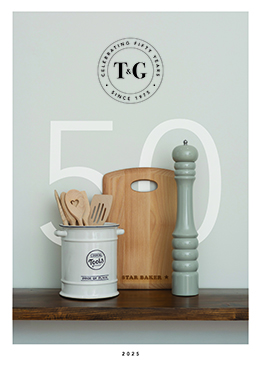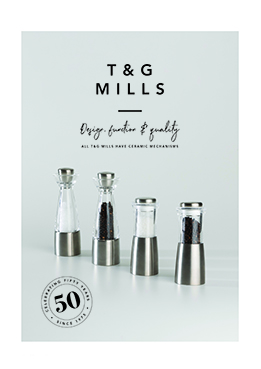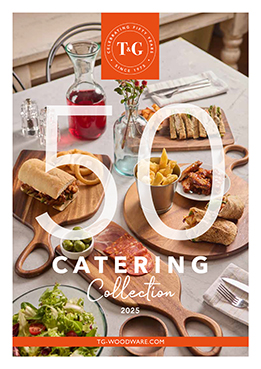FAQs
1. How do I care for my new chopping board ?
- Do not soak in water.
- Keep away from heat and direct sunlight, e.g. window ledge.
- Do not put in oven or microwave.
- Do not put in dishwasher.
The most hygienic board is a properly cleaned board, just wash under a running tap to remove all food residue, lightly dry with a cloth and stand it on its side, along the grain not on the end with the end-grain. To enhance its appearance and extend its life occasionally rub in T&G’s Food Safe Wood Oil.
Properly looked after, your children will inherit your boards.
For details on the hygienic properties of wooden cutting boards see care instructions.
2. Can I use vegetable oil to preserve and improve the appearance of my boards; bowls and other pieces of kitchen Woodware ?
Vegetable oils leave a sticky surface on wooden boards which is not an hygienic medium for using with food. Vegetable oils to preserve wood do not penetrate as deep as T&G’s Food safe wood oil. With vegetable oil the sticky surface also becomes rough as the knap of the wood sticks up and feels like coarse sandpaper although, vegetable oils will not do any harm.
For further details see our care and use section “The Microbiology of Wooden Cutting Boards”.
3. Why are end-grain boards so popular?
The construction of end-grain is produced in a similar way to the large traditional table blocks used by butchers. This construction is very robust but kinder to knives; it is like cutting into closely packed fibres of a brush instead of across the fibres. Butchers will leave a damp cloth overnight on these commercial blocks in order to swell the wood to fill in small gaps; this is not required for domestic blocks and should be discouraged.
4. Plastic boards are often recommended for hygiene in the kitchen, should I replace my wood boards with plastic (polyethylene).
Wood is remarkable in that there are mechanisms that operate to inhibit the growth of bacteria and which eventually die in a few hours after the board has been dried.
Tests conducted in 2 Universities in the U.S.A. for the F.D.A. (Federal Drug Administration) have shown that,when considering hygiene, wooden boards perform better than plastic boards, in most domestic kitchens.
For more details see our section on care and use- Wooden boards, and “The Microbiology of Wooden Boards”
N.B. The anti-bacterial chemical applied to T&G’s Polyethylene boards is derived from trees! No wonder there are so many trees 1,000 years old.
Download our Chopping Board Care Guide
6. Where does Cork come from?
More than half the world’s tonnage of cork is produced in Portugal from plantations not just in Portugal but also in Spain and North Africa. Cork is also grown in many of the countries that border the Mediterranean.
Cork is the outer bark of the cork oak (quercus suber) and is stripped from trees every 9 or 10 years around June.
It has many applications apart from the stoppers for wine and champagne bottles plus our Tablemats, coasters, pot stands and trays. These include floor and wall coverings, handles for fishing rods and tennis rackets, cricket balls, shuttlecocks and other sports equipment; buoys, gaskets, pressure joints just to name a few, the list is endless!
7. Why is Cork popular for tablemats, coasters, pot stands and trays?
- Cork is a unique natural material with amazing properties for insulation so it will protect tabletops from heat.
- Cork is made from millions of self-contained cells and so liquids do not penetrate from cell to cell, this means it is highly resistant to staining. See our Care and use section for cleaning cork surfaces
- Cork has a natural non-slip surface so plates will not slide as they do on melamine mats. For trays, glasses and bottles will be much more stable and will also not slide on natural cork even when the tray is tipped at high angles.
- For the versatile uses of this natural material it is extremely light but strong, particularly useful with trays. Cork is 50% air.
8. If Cork stripping takes off the bark, why does this not kill the tree thereby destroying the environment?
Cork is one of the world’s most environmentally proven materials. It is the outer bark that is stripped leaving an inner bark to allow for the transfer of nutrients up the trunk of the tree. This regenerates over the next 9 or 10 years so that cork trees can still be producing after 300 years.
Cork trees also provide a marvellous habitat for wildlife, from birds to plants, many of which are unique to cork woodlands.
9. I have always been told not to put sea salt in peppermills, is this true?
If you have a peppermill with a metal grinder then, yes this is true; however, the Industry producing peppermills was transformed around 1997 with the introduction of the Crushgrind mechanism. With a metal grinder, no matter how good, salt will corrode the working parts and eventually the grinder will seize and possibly no longer turn. Crushgrind's new ceramic will not corrode, it will last longer than steel, in fact, you could put salt and pepper in together with even some chilli flakes for a really spicy mix. T&G's Crushgrind ceramic grinder is much more versatile, you can grind dried herbs and spices using the same mechanism and with the extra large cutting surface the yield with each turn is greater than other grinders on the market.
10. How can I adjust the grade of Pepper from coarse to fine?
Most mills can only be adjusted by using the knob at the top - loose or tight but every time you turn the grinder this adjustment floats between the scale of adjustments and so a consistent grade is not possible. T&G Woodware has several mills with the adjustment in the base, the most famous of which are the Crushgrind models. If you turn the base of a Crushgrind up you will see a grey wheel, by turning this wheel you can move from fine to coarse over about 14 settings, what is important is that each setting is held in place which can be felt with a click, so you can set the grinder at whatever level you want: Cracked pepper for steaks or fish to almost a powder for omelettes or sauces. A tip is to set it at a medium setting as the best grinding is the final grind -- done with the teeth!
11. Why does salt and pepper come out of the bottom of my mills after grinding?
Fine particles of salt or pepper are produced during the grinding process. These fall to the bottom of the mill and come out as a fine ‘dust’. Shaking your mills after grinding will remove excess grounds. Mills can be stored on a mill rest, a handy accessory that catches all the dust. Alternatively choose an upside down mill, which has it’s mechanism at the top.
12. Where should I store my mills?
Always store mills in a dry atmosphere; never let the mills or the contents come into contact with water or steam.
13. Are ceramic mechanisms corrosive?
No, unlike metal, ceramic does not rust or corrode, which makes it easy to clean.
14. Can I wash my mill?
The core of the ceramic mechanism can be removed and washed in soapy water with the outer (or crown) section becoming visible to brush clean. Do not immerse the body of any mill in water or put in a dishwasher. If the body of the mill needs cleaning, wipe with a damp cloth and polish dry.
15. Can I use red pepper in my mill?
Only if its mixed with white, green and black peppercorns. Otherwise, its moistness (red pepper is not real pepper but actually a seed) can clog up the grinder.
16. Can I grind herbs in my mill?
Yes, T&G’s Spice mills with CrushGrind® ceramic grinder is great for grinding dried herbs and spices. These tend to quickly lose aroma and flavour once they are ground, because the essential oils evaporate. Buying coarsely ground dried seasonings and milling them when required releases the essential oils, making the seasonings smell and taste as good as fresh-picked ones.
17. I have lost/damaged the top of my peppermill?
Just contact our customer services department, it would be unusual if we were unable to find a replacement.
For more information on T&G prducts please watch one our informative product videos www.youtube.com/user/tgwoodwareltd/videos



